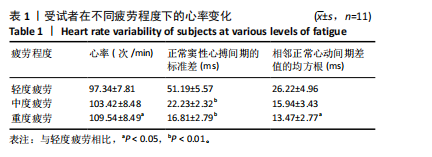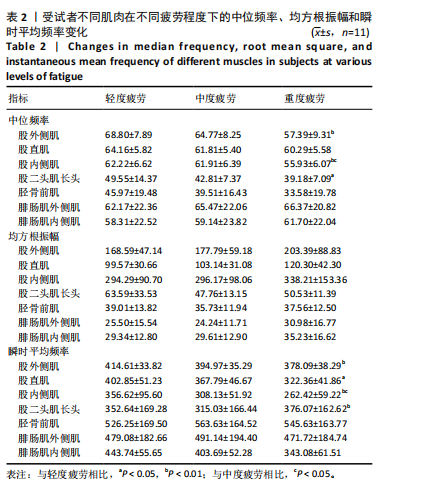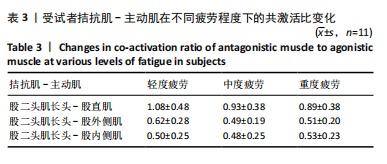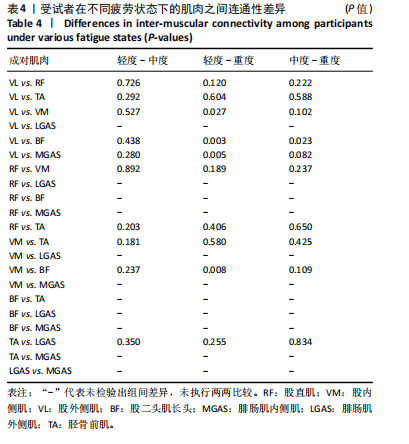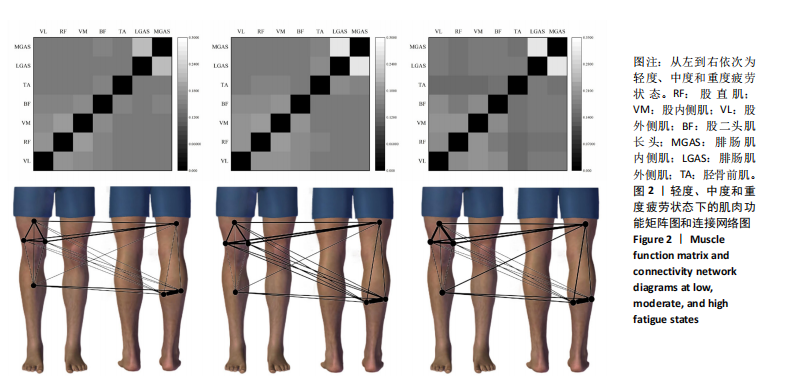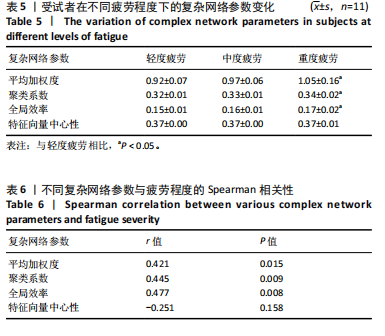[1] 胡海旭.竞技能力增长理论模型及其演进[J].体育科学,2016,36(2): 14-24+40.
[2] RUSSELL S, JOHNSTON RD, STANIMIROVIC R, et al. Global practitioner assessment and management of mental fatigue and mental recovery in high-performance sport: A need for evidence-based best-practice guidelines. Scand J Med Sci Sports. 2024;34(1):e14491.
[3] YODA IK, TISNA GD, SUWIWA IG, et al. Recovery methods to reduce fatigue among athletes: A systematic review and future directions. J Sport Area. 2024;9(2):217-234.
[4] SCHLINK BR, NORDIN AD, BROOKS CN, et al. Fatigue induces altered spatial myoelectric activation patterns in the medial gastrocnemius during locomotion. J Neurophysiol. 2021;125(5):2013-2023.
[5] GANTOIS P, CAPUTO FERREIRA ME, LIMA-JUNIOR D, et al. Effects of mental fatigue on passing decision-making performance in professional soccer athletes. Eur J Sport Sci. 2020;20(4):534-543.
[6] MCCLEAN ZJ, PASANEN K, LUN V, et al. A Biopsychosocial Model for Understanding Training Load, Fatigue, and Musculoskeletal Sport Injury in University Athletes: A Scoping Review. J Strength Cond Res. 2024;38(6):1177-1188.
[7] SAYYADI P, MINOONEJAD H, SEIDI F, et al. The effectiveness of fatigue on repositioning sense of lower extremities: systematic review and meta-analysis. BMC Sports Sci Med Rehabil. 2024;16(1):35.
[8] SUN J, LIU G, SUN Y, et al. Application of Surface Electromyography in Exercise Fatigue: A Review. Front Syst Neurosci. 2022;16:893275.
[9] LI N, ZHOU R, KRISHNA B, et al. Non-invasive Techniques for Muscle Fatigue Monitoring: A Comprehensive Survey. ACM Comput Surv. 2024;56(9):1-40.
[10] NAIR RR, VENUGOPAL G, SWAMINATHAN R. Analysis of Muscle Fiber Type Proportions in Surface Electromyography Signals of Athletes Using Reassigned Morlet Scalogram. IEEE Trans Instrum Meas. 2024;73(1-10): 6502710.
[11] 徐红旗,史冀鹏,张守伟,等. sEMG时频特征线性回归法与非线性神经网络法预测伸膝肌群极限功率保持能力测试中功率损失率的比较研究[J].中国体育科技,2017,53(2):53-63.
[12] 徐红旗,史冀鹏,张欣,等.表面肌电小波变换分析技术监测重复性手工提放重物作业中机体肌肉疲劳的研究[J].体育科学,2011, 31(12):44-54.
[13] YOON W, SHIN G. Muscle fatigue tracking during dynamic elbow flexion-extension movements with a varying hand load. Appl Ergon. 2024;116:104217.
[14] WANG C, WANG X, LI Q, et al. Recognizing and predicting muscular fatigue of biceps brachii in motion with novel fabric strain sensors based on machine learning. Biomed Signal Process Control. 2024;96: 106647.
[15] SHARIATZADEH MJ, HAFSHEJANI EH, MITCHELL CJ, et al. Predicting muscle fatigue during dynamic contractions using wavelet analysis of surface electromyography signal. Biocybern Biomed Eng. 2023;43(2): 428-441.
[16] DANIEL N, MAŁACHOWSKI J. Wavelet analysis of the EMG signal to assess muscle fatigue in the lower extremities during symmetric movement on a rowing ergometer. Acta Bioeng Biomech. 2023;25(2): 15-27.
[17] HOFSTE A, SOER R, SALOMONS E, et al. Intramuscular EMG Versus Surface EMG of Lumbar Multifidus and Erector Spinae in Healthy Participants. Spine (Phila Pa 1976). 2020;45(20):E1319-E1325.
[18] ORTEGA-AURIOL PA, BESIER TF, BYBLOW WD, et al. Fatigue Influences the Recruitment, but Not Structure, of Muscle Synergies. Front Hum Neurosci. 2018;12:217.
[19] ZHAO K, ZHANG Z, WEN H, et al. Muscle synergies for evaluating upper limb in clinical applications: A systematic review. Heliyon. 2023; 9(5):e16202.
[20] 陈仕吉,崔腾腾,邱均平.学科交叉动力学分析研究综述[J].数据分析与知识发现,2022,6(5):1-9.
[21] 肖汉,张艳花,山洁,等.基于社会网络分析的高校图书馆图书资源利用研究[J].图书馆理论与实践,2020(5):26-30,51.
[22] 郭峰,袁维帅,王新,等.视觉对人体姿势控制影响的脑功能网络连接机制[J].医用生物力学,2024,39(2):285-292.
[23] 崔彩虹,缪华聪,梁铁,等.基于表面肌电信号的不同步行速度下肌肉协同及肌肉功能网络分析[J].生物医学工程学杂志,2023,40(5): 938-944.
[24] 陈玲玲,张存,宋晓伟,等.面向外骨骼机器人的肌肉功能网络构建及分析[J].生物医学工程学杂志,2019,36(4):565-572.
[25] O’KEEFFE R, SHIRAZI SY, MEHRDAD S, et al. Perilaryngeal functional muscle network in patients with vocal hyperfunction-a case study. Baltimore:Proceedings of the 2023 11th International IEEE/EMBS Conference on Neural Engineering (NER), 2023.
[26] HOUSTON M, LI X, ZHOU P, et al. Alterations in Muscle Networks in the Upper Extremity of Chronic Stroke Survivors. IEEE Trans Neural Syst Rehabil Eng. 2021;29:1026-1034.
[27] NAGAI T, SCHILATY ND, LASKOWSKI ER, et al. Hop tests can result in higher limb symmetry index values than isokinetic strength and leg press tests in patients following ACL reconstruction. Knee Surg Sports Traumatol Arthrosc. 2020;28(3):816-822.
[28] BORG G. Borg’s perceived exertion and pain scales. Champaign: Human Kinetics, 1998.
[29] HERMENS HJ, FRERIKS B, DISSELHORST-KLUG C, et al. Development of recommendations for SEMG sensors and sensor placement procedures. J Electromyogr Kinesiol. 2000;10(5):361-374.
[30] MIRANDA H, MAIA M, DE OLIVEIRA CG, et al. Myoeletric indices of fatigue adopting different rest intervals during leg press sets. J Bodyw Mov Ther. 2018;22(1):178-183.
[31] HAHN D. Lower extremity extension force and electromyography properties as a function of knee angle and their relation to joint torques: implications for strength diagnostics. J Strength Cond Res. 2011;25(6):1622-1631.
[32] AUGUSTSSON J, THOMEÉ R, HÖRNSTEDT P, et al. Effect of pre-exhaustion exercise on lower-extremity muscle activation during a leg press exercise. J Strength Cond Res. 2003;17(2):411-416.
[33] XU HQ, XUE YT, ZHOU ZJ, et al. Retentive capacity of power output and linear versus non-linear mapping of power loss in the isotonic muscular endurance test. Sci Rep. 2021;11(1):22677.
[34] CICCONE AB, SIEDLIK JA, WECHT JM, et al. Reminder: RMSSD and SD1 are identical heart rate variability metrics. Muscle Nerve. 2017;56(4): 674-678.
[35] 吴成亮,郝卫亚,李旭鸿,等.体操运动员后空翻落地与垂直落地的下肢生物力学比较研究[J].中国体育科技,2022,58(5):21-26+83.
[36] 李萍,朱学强,李秀红,等.运动损伤预防训练对短跑运动员下肢生物力学和共激活特征的影响[J].中国体育科技,2021,57(11):30-37.
[37] 王元东.运动想象中的大脑网络可塑性研究[D].济南:齐鲁工业大学,2023.
[38] 张夏冰.上肢动作相关脑、肌电生理网络研究[D].成都:电子科技大学,2023.
[39] RUBINOV M, SPORNS O. Complex network measures of brain connectivity: uses and interpretations. Neuroimage. 2010;52(3):1059-1069.
[40] 李海林,陈多,林伟滨.合作网络整体性特征对科研团队创新绩效的影响研究:以(国际)医学信息学领域研究论文为例[J].情报科学,2023,41(5):59-67.
[41] 赵霞,李会会.经济政策不确定性与股票市场存在双向溢出效应吗?:基于尾部风险网络的视角[J].上海对外经贸大学学报, 2023,30(5):92-106.
[42] CHEN Z, YAN J, SONG X, et al. Heavier Load Alters Upper Limb Muscle Synergy with Correlated fNIRS Responses in BA4 and BA6. Cyborg Bionic Syst. 2023;4:0033.
[43] ZHAO H, SEO D, OKADA J. Validity of using perceived exertion to assess muscle fatigue during back squat exercise. BMC Sports Sci Med Rehabil. 2023;15(1):14.
[44] GAO Z, ZHAO L, FEKETE G, et al. Continuous time series analysis on the effects of induced running fatigue on leg symmetry using kinematics and kinetic variables: Implications for knee joint injury during a countermovement jump. Front Physiol. 2022;13:877394.
[45] JOHN AT, WIND J, HORST F, et al. Acute Effects of an Incremental Exercise Test on Psychophysiological Variables and Their Interaction. J Sports Sci Med. 2020;19(3):596-612.
[46] HALPERIN I, EMANUEL A. Rating of Perceived Effort: Methodological Concerns and Future Directions. Sports Med. 2020;50(4):679-687.
[47] 麦全安,张勇.网球锻炼对老年人平衡能力影响的实验研究[J].体育学刊,2019,26(4):140-144.
[48] 王宏棣,周志芳,何金存,等.运动员运动生理生化指标与体育木地板运动功能的相关性[J].林业科学,2020,56(1):172-179.
[49] 朱欢,高炳宏.微血管反应性在耐力性运动员训练中的应用[J].中国运动医学杂志,2019,38(10):907-914.
[50] 易灿南,唐范,左华丽,等.基于sEMG的拉物行走作业肌肉疲劳发展机理研究[J].人类工效学,2022,28(1):37-42.
[51] TESCH PA, DUDLEY GA, DUVOISIN MR, et al. Force and EMG signal patterns during repeated bouts of concentric or eccentric muscle actions. Acta Physiol Scand. 1990;138(3):263-271.
[52] AMENT W, BONGA GJ, HOF AL, et al. Electromyogram median power frequency in dynamic exercise at medium exercise intensities. Eur J Appl Physiol Occup Physiol. 1996;74(1-2):180-186.
[53] O’KEEFFE R, SHIRAZI SY, YANG J, et al. Non-parametric Functional Muscle Network as a Robust Biomarker of Fatigue. IEEE J Biomed Health Inform. 2023;27(4):2105-2116.
[54] SJÖBERG M, BERG HE, NORRBRAND L, et al. Comparison of Joint and Muscle Biomechanics in Maximal Flywheel Squat and Leg Press. Front Sports Act Living. 2021;3:686335.
[55] OSU R, FRANKLIN DW, KATO H, et al. Short- and long-term changes in joint co-contraction associated with motor learning as revealed from surface EMG. J Neurophysiol. 2002;88(2):991-1004.
[56] KRISTIANSEN M, SAMANI A, MADELEINE P, et al. Effects of 5 Weeks of Bench Press Training on Muscle Synergies: A Randomized Controlled Study. J Strength Cond Res. 2016;30(7):1948-1959.
[57] 张海红,王健.双侧屈伸肘运动中主动肌与拮抗肌的表面肌电图变化[J].中国运动医学杂志,2009,28(4):431-435.
[58] 黄耐寒.基于表面肌电的肌疲劳分析与肌力预测研究及实现[D].合肥:中国科学技术大学,2014.
[59] HAJILOO B, ANBARIAN M, ESMAEILI H, et al. The effects of fatigue on synergy of selected lower limb muscles during running. J Biomech. 2020;103:109692.
[60] 贾彬彬,李丹阳,吕辰楠,等.运动负荷对抗阻训练下皮层神经活动特征的影响:来自fNIRS的证据[J].武汉体育学院学报,2024, 58(2):63-70+80.
[61] LIU X, CUI X, LIANG T, et al. Characteristics analysis of muscle function network and its application to muscle compensatory in repetitive movement. Biomed Signal Process Control. 2023;83:104639.
[62] CAO L, LI L, HUANG Z, et al. Functional network segregation is associated with higher functional connectivity in endurance runners. Neurosci Lett. 2023;812:137401.
|
